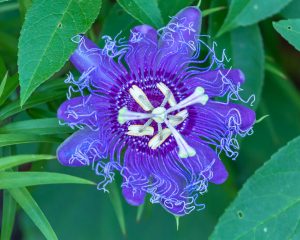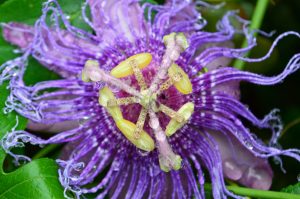Purple Passionflower
Purple passionflower (Passiflora incarnata), both handsome and hardy, is a native that frequents fields and fencerows across our state.
A day in the sun
The sun-loving perennial vine produces showy, exotic flowers during summer–but look fast! Each lavender bloom lasts less than a day before it shrivels and sets fruit over the course of several months.
Far and wide
The passionflower’s tenacious tendrils cling to walls and arbors as vines reach up, up and away. Contain them, or runners will spread at breakneck speed: 1 in. a day … and up to 30 feet long!
Butterfly buddy
Butterflies love to visit this flowering plant. In fact, it is the only host for the gulf fritillary and zebra longwing butterflies. Bees, moths, bats and hummingbirds are frequent guests, too.
Olfactory overload
Another bonus of the bodacious bloom is its distinctive tutti-frutti fragrance.
Ripe for the picking
The passionflower’s mature fruit is an oval berry, about the size of a small hen egg. Green at first, the berry turns to yellow. It is tasty fresh off the vine or as a tart addition to homemade jellies and jams.

Purple passionflower (Passiflora incarnata) looks like it’s out of this world! Photo by Tom Hennessy
Maypop
Its nickname—maypop—hints at what happens if you happen to step on its hollow fruit.
Spiritual symbolism
The passionflower supposedly points to the Christian crucifixion story (also called the Passion). The bloom’s 10 petal-like parts represent Jesus’ disciples (excluding deniers Peter and Judas), the five stamens signify Jesus’ wounds, the knob-like stigmas suggest the nails, and the fringed ring resembles the crown of thorns.
Relatively speaking
Its sister variety, yellow passionflower (Passiflora lutea), is also native to Virginia, but less known — and less dramatic, with smaller yellow flowers.
Look for passionflowers in the Children’s Garden and along the Cherry Tree Walk at Lewis Ginter Botanical Garden.
Note: This article first appeared in the Discover Richmond magazine.
